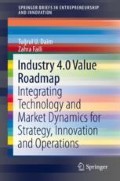Abstract
Intelligent car concept is the main factor in the big data strategy of the automotive sector. Its use case should be properly realized in order to ensure its successful implementation on a larger scale. In this concept, not only there is a huge amount of real-time data being gathered but also a platform for a direct publication of the data to the driver via the big data analysis (Voigt et al. 2014). This has resulted in new business and service opportunities across industries while having added value to the service provider, the OEMs as well as the end customer (driver). One of the examples that BMW took was its ConnectedDrive initiative that offers a unique app for monitoring the real-time traffic, concierge service, intelligent emergency call, infotainment, and so forth. This shows the possibility of mass customization which can be achieved via big data.
Access this chapter
Tax calculation will be finalised at checkout
Purchases are for personal use only
References
Belle, A., et al. (2015). Big data analytics in healthcare. Journal of Biomedicine and Biotechnology.
Boschert, S., Heinrich, C., & Rosen, R. (2018). Next generation digital twin. s.l., Proceedings of TMCE 2018, 7–11 May, 2018, Las Palmas de Gran Canaria, Spain.
Bruynseels, K., Santoni de Sio, F., & Van den Hoven, J. (2018). Digital twins in health care: Ethical implications of an emerging engineering paradigm. Front Genet, 9, 31.
Budianto, E., et al. (2011). Telecommunication networks coverage area expansion in disaster area using autonomous mobile robots: Hardware and software implementation.
Chen, C.M. (2016). Use cases and challenges in telecom big data analytics. APSIPA Transactions on Signal and Information Processing, 5.
Dhall, R., & Solanki, V. (2017). An IoT based predictive connected car maintenance approach. International Journal of Interactive Multimedia and Artificial Intelligence, 4(3), 16–22.
Gamper, H., & Lokki, T. (2010). Audio augmented reality in telecommunication through virtual. s.l., The 16th International Conference on Auditory Display.
Gao, F., Thiebes, S., & Sunyaev, A. (2018). Rethinking the meaning of cloud computing for health care: A taxonomic perspective and future research directions. Journal of Medical Internet Research, 20(7), e10041.
Ghafoor, K. Z., Mohammed, M. A., Bakar, K. A., Sadiq, A. S., & Lloret, J. (2014). Vehicular cloud computing.
Goulding, C. (2018). 3D printing 5G telecommunication technology. [Online]. Retrieved October 2018, from https://3dprint.com/217744/3d-printing-5g-telecommunication/
Himperich, F. (2007). Applications of augmented reality in the automotive industry. pp. 1–21.
Kadry, S., Abid, M., & Ionescu, S. (2018). Preventive & predictive maintenance of telecommunication equipment—A review. s.l., Steifedine Kadry.
Malim, G. (2018). The global voice of telecoms IT. [Online]. Retrieved October 2018, from https://www.vanillaplus.com/2018/05/21/38426-can-telecoms-industry-successfully-adopt-digital-twins/
Manghnani, R. (2015). An exploratory study: The impact of additive manufacturing on the automobile industry. International Journal of Current Engineering and Technology, 5(5), 3407–3410.
Mills, D. (2015). Future medicine: The impact of 3D printing. Journal of Nanomaterials & Molecular Nanotechnology. 4(3).
Ranky, P. G. (2002). Advanced digital automobile sensor applications. Sensor Review, 22(3), 213–217.
Riek, L. (2017). Healthcare robotics. Communications of the ACM, 60(11), 68–78.
Saleh, N., et al. (2015). Preventive maintenance prioritization index of medical equipment using quality function deployment. IEEE Journal of Biomedical and Health Informatics, 19(3), 1029–1035.
Scholz-Reiter, B., & Freitag, M. (2007). Autonomous processes in assembly systems. CIRP Annals, 56(2), 712–729.
Tang, S.-L., et al. (1998). Augmented reality systems for medical applications. IEEE Engineering in Medicine and Biology, 17(3), 49–58.
Thayananthan, V., & Basuhail, A. (2017). Integration of wearable smart sensor for improving e-healthcare. International Journal of Advanced Computer Science and Applications (IJACSA), 8(12), 389–395.
Vajda, A., et al. (2012). Cloud computing and telecommunications: Business opportunities, technologies and experimental setup.
Voigt, M., Bennison, C., & Hammerschmidt, M. (2014). Big data in the automotive industry. 360°—the Business Transformation Journal, 10.
Wang, Q., & Balasingham, I. (2010). Wireless sensor networks—An introduction.
Author information
Authors and Affiliations
Rights and permissions
Copyright information
© 2019 The Author(s), under exclusive license to Springer Nature Switzerland AG
About this chapter
Cite this chapter
Daim, T.U., Faili, Z. (2019). Enablers: Industry 4.0. In: Industry 4.0 Value Roadmap. SpringerBriefs in Entrepreneurship and Innovation. Springer, Cham. https://doi.org/10.1007/978-3-030-30066-1_3
Download citation
DOI: https://doi.org/10.1007/978-3-030-30066-1_3
Published:
Publisher Name: Springer, Cham
Print ISBN: 978-3-030-30065-4
Online ISBN: 978-3-030-30066-1
eBook Packages: Literature, Cultural and Media StudiesLiterature, Cultural and Media Studies (R0)

